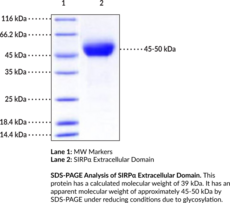Territorial Availability: Available through Bertin Technologies only in France
- Correlated keywords
- SIRP-? a SHP1 SHP2 CD-47 172A 172 A MyD1 SHPS1 PTPNS1 PTPNS 1 P84 P-84 MFR BIT HEK-293 Glu-31
- Product Overview:
Signal regulatory protein ? (SIRP?) is an inhibitory transmembrane receptor encoded by SIRPA in humans.{53810,53811} It is composed of three extracellular immunoglobulin-like (Ig-like) domains, a single transmembrane region, and a cytoplasmic domain that contains four tyrosine residues with immunoreceptor tyrosine-based inhibitory motifs (ITIMs) that are essential to SIRP? interaction with the Src homology region 2 (SH2) domain-containing phosphatases SHP-1 and SHP-2.{53811} SIRP? is expressed on monocytes, macrophages, granulocytes, subsets of dendritic cells in lymphoid tissues, some bone marrow progenitor cells, and neurons. Binding of CD47 (Item No. 32085), a receptor expressed on healthy cells but often overexpressed in cancer cells, to SIRP? induces phosphorylation of the SIRP? ITIMs, coupling to SHP-1 or SHP-2, and repression of immune cell activation and phagocytosis.{53810,53811} Knockout of Sirpa increases dopaminergic neuronal loss in the substantia nigra pars compacta and enhances striatal microglia activation in a mouse model of MPTP-induced Parkinson’s disease.{53812} Sirpa-/- mice exhibit increased age-related podocyte injury and proteinuria compared with wild-type mice.{53813} SIRPA expression is decreased in patients with focal segmental glomerular sclerosis and in mouse models of renal injury induced by puromycin aminonucleoside (Item No. 15509), doxorubicin (Item No. 15007), or streptozotocin (Item No. 13104). Cayman’s SIRP? Extracellular Domain (human, recombinant) protein can be used for ELISA. This protein consists of 351 amino acids, has a calculated molecular weight of 39 kDa, and a predicted N-terminus of Glu31 after signal peptide cleavage. By SDS-PAGE, under reducing conditions, the apparent molecular mass of this protein is 45 to 50 kDa due to glycosylation.
Cayman Chemical’s mission is to help make research possible by supplying scientists worldwide with the basic research tools necessary for advancing human and animal health. Our utmost commitment to healthcare researchers is to offer the highest quality products with an affordable pricing policy.
Our scientists are experts in the synthesis, purification, and characterization of biochemicals ranging from small drug-like heterocycles to complex biolipids, fatty acids, and many others. We are also highly skilled in all aspects of assay and antibody development, protein expression, crystallization, and structure determination.
Over the past thirty years, Cayman developed a deep knowledge base in lipid biochemistry, including research involving the arachidonic acid cascade, inositol phosphates, and cannabinoids. This knowledge enabled the production of reagents of exceptional quality for cancer, oxidative injury, epigenetics, neuroscience, inflammation, metabolism, and many additional lines of research.
Our organic and analytical chemists specialize in the rapid development of manufacturing processes and analytical methods to carry out clinical and commercial GMP-API production. Pre-clinical drug discovery efforts are currently underway in the areas of bone restoration and repair, muscular dystrophy, oncology, and inflammation. A separate group of Ph.D.-level scientists are dedicated to offering Hit-to-Lead Discovery and Profiling Services for epigenetic targets. Our knowledgeable chemists can be contracted to perform complete sample analysis for analytes measured by the majority of our assays. We also offer a wide range of analytical services using LC-MS/MS, HPLC, GC, and many other techniques.
Accreditations
ISO/IEC 17025:2005
ISO Guide 34:2009
Cayman is a leader in the field of emerging drugs of abuse, providing high-purity Schedule I-V Controlled Substances to federally-licensed laboratories and qualified academic research institutions for forensic analyses. We are certified by ACLASS Accreditation Services with dual accreditation to ISO/IEC 17025:2005 and ISO Guide 34:2009.





